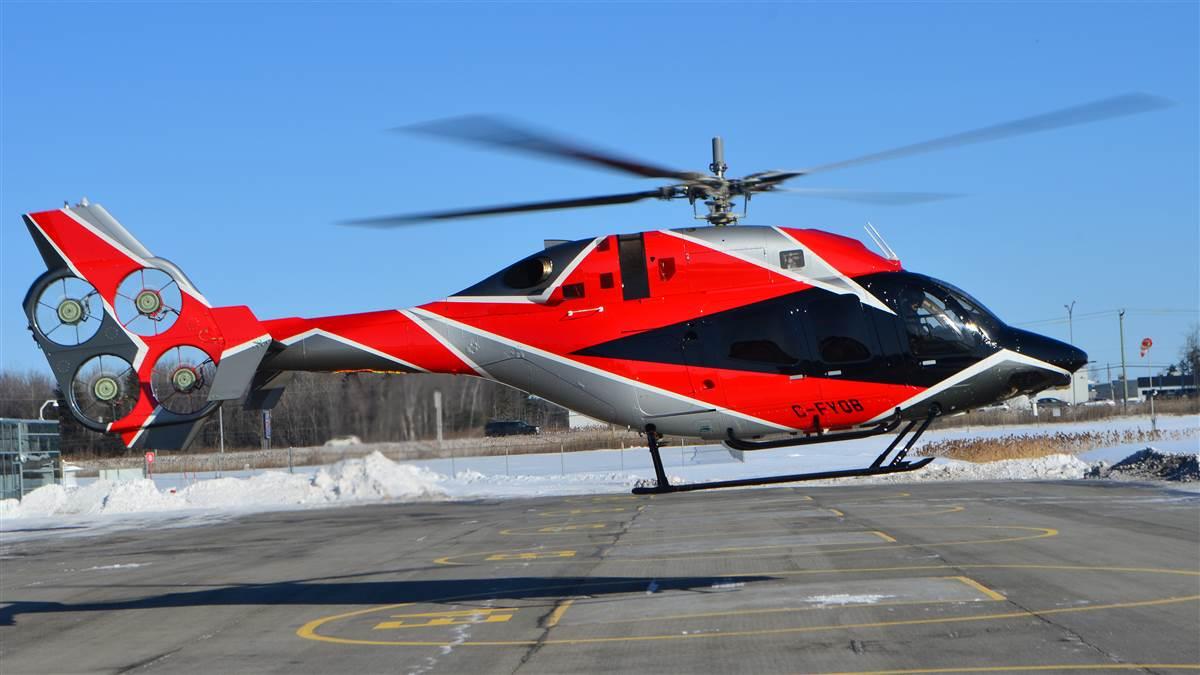Future Flight: Bell debuts electric tail rotor
Systems is said to be safer

It’s called electrically distributed anti-torque (EDAT), and it replaces the traditional single tail rotor with four electric motors powering four rotors in a shrouded tail section. Although in flight testing since May 2019, the system was made public in February.
Helicopter tail rotors have long been a source of engineering fiddling. There’s MD Helicopters’ NOTAR (no tail rotor) and Airbus’ Fenestron (Provençal for “little window”), and coaxial models in development. The tail rotor saps power from the main rotor, puts out a high-pitched noise signature, and is dangerous for people on the ground.
Bell said EDAT may solve many of these problems. Safety is probably the biggest benefit. Because the small rotors are variable speed, and not variable pitch at a constant speed, they can turn off completely when the helicopter is on the ground, allowing for hot ingress and egress with no danger. The company also said redundancy is improved, because there is still tail rotor authority with three of the four rotors inoperative. The four electric motors are powered by an engine-driven generator. That would indicate that power is still being siphoned from the main rotor, but it’s easy to see future scenarios where batteries or a hybrid solution power the system.
To this point Bell has been testing the system for overall viability, but officials have said that it will go into an optimization program at some point soon. Although the program is in the commercial helicopter division, it only takes one look to imagine the small rotors mounted horizontally on an eVTOL aircraft. Conventional wisdom had said that eVTOL technology would trickle down to traditional aircraft, but it appears in Bell’s case that some of it might move the other direction. The system is fly-by-wire with no mechanical linkage to the anti-torque pedals, and the build partner, Safran, is also working with Bell on future optionally piloted technology.
Email [email protected]
AOPA Flight Planner to sunset
Jeppesen is decommissioning its legacy map engine that powers much of the information in the AOPA Flight Planner. Because of this, AOPA planned to sunset the planner by the end of April. The engine that powers the Flight Planner has become obsolete. After March 31, the Flight Planner will no longer be supported, and it will no longer be available after April 30. AOPA and Jeppesen, a Boeing company, have long partnered to bring members the Flight Planner.
“With the flight planning engine that powers the current AOPA Flight Planner being decommissioned, AOPA has to move ahead and look at new ways to provide pilots access to other desktop flight planners, and to have access to great EFB options for when they fly,” said Jiri Marousek, AOPA senior vice president of marketing.
“We will keep working with the industry, and adding those options as quickly as possible. We understand that any change of tool like the Flight Planner is inconvenient for any pilot using it, and we are working to minimize that. Of course, we are also focused on our critical mission of protecting and growing aviation, training and educating pilots to be better and safer, and adding benefits for AOPA pilots.”
AOPA's other tools that help pilots plan their flights will still be available, including weather and the AOPA Airport Directory, which offers downloadable approach plates and taxi diagrams.
 Humble beginnings are two words used often for people whose hard work and ingenuity make them legends. Such is the case of Bessie Pittman, er, Jacqueline Cochran, also known as the Speed Queen, director of the Women Airforce Service Pilots (WASP), colonel in the U.S. Air Force Reserves, first woman pilot to “go supersonic,” and recipient of the Distinguished Flying Cross.
Humble beginnings are two words used often for people whose hard work and ingenuity make them legends. Such is the case of Bessie Pittman, er, Jacqueline Cochran, also known as the Speed Queen, director of the Women Airforce Service Pilots (WASP), colonel in the U.S. Air Force Reserves, first woman pilot to “go supersonic,” and recipient of the Distinguished Flying Cross. 


